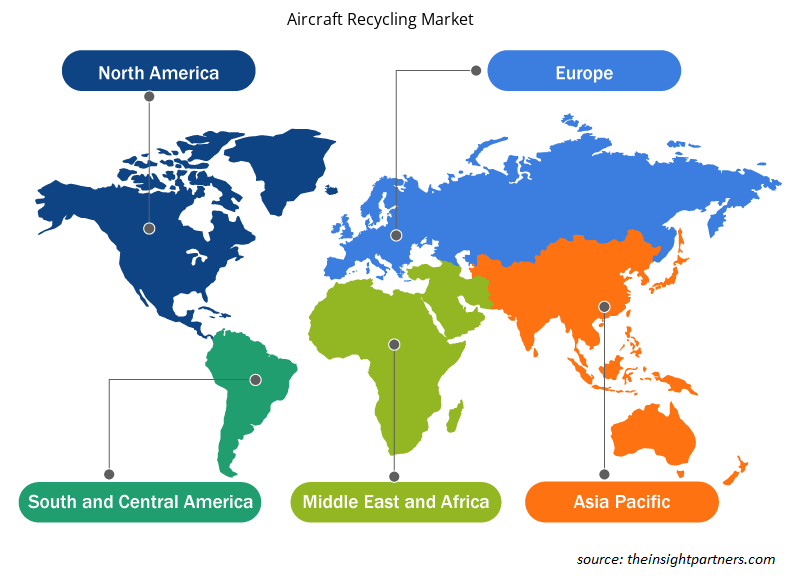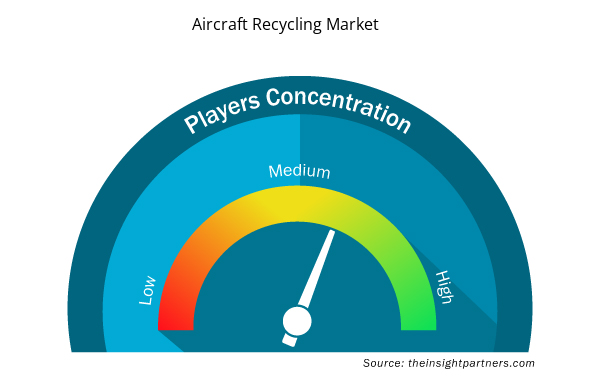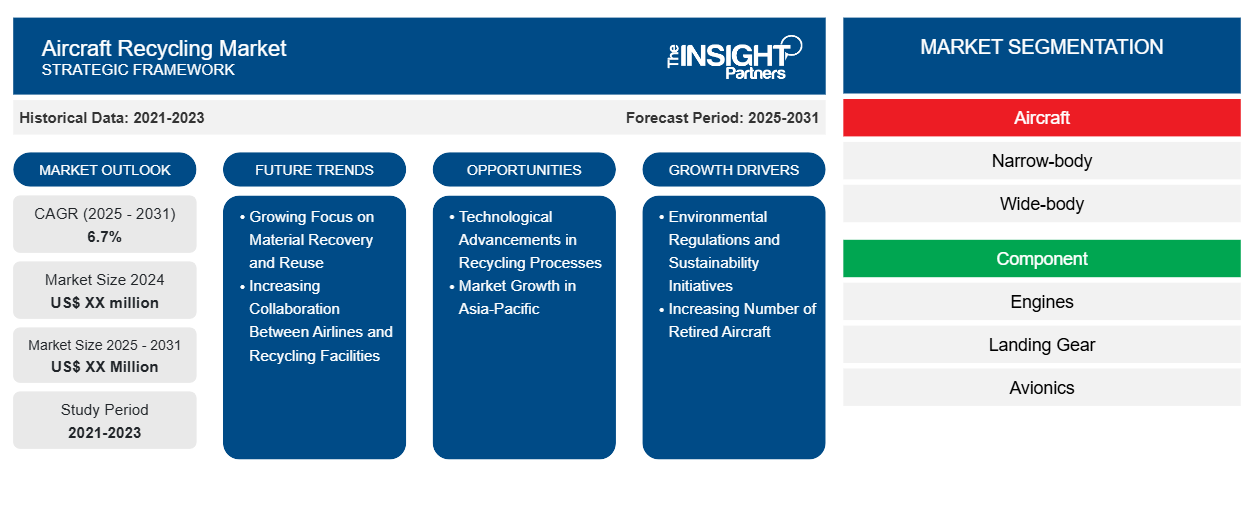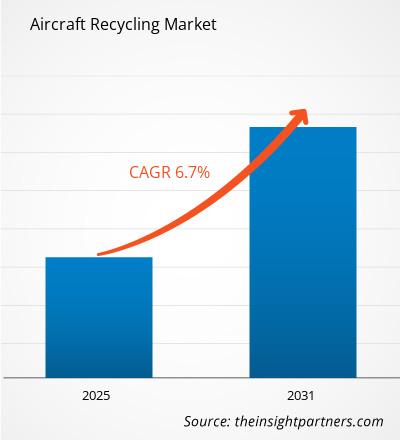항공기 재활용 시장은 2023년부터 2031년까지 6.7%의 CAGR을 기록할 것으로 예상되며, 시장 규모는 2023년의 XX백만 달러에서 2031년 XX백만 달러로 확대될 것으로 예상됩니다.
보고서는 항공기(협동체, 광동체)로 세분화됩니다. 보고서는 또한 구성 요소(엔진, 랜딩 기어, 항공 전자 장비)를 기반으로 분석을 제시합니다. 보고서는 또한 재료(알루미늄, 기타 금속, 합금)를 기반으로 분석을 제시합니다. 글로벌 분석은 지역 수준과 주요 국가로 더 세분화됩니다. 보고서는 위의 분석 및 세그먼트에 대한 USD 가치를 제공합니다.
보고서의 목적
The Insight Partners의 항공기 재활용 시장 보고서는 현재의 상황과 미래 성장, 주요 추진 요인, 과제, 기회를 설명하는 것을 목표로 합니다. 이를 통해 다음과 같은 다양한 비즈니스 이해 관계자에게 통찰력을 제공합니다.
- 기술 제공업체/제조업체: 변화하는 시장 역학을 이해하고 잠재적인 성장 기회를 파악하여 정보에 입각한 전략적 결정을 내릴 수 있도록 합니다.
- 투자자: 시장 성장률, 시장 재무 전망, 가치 사슬 전반에 존재하는 기회에 대한 포괄적인 추세 분석을 수행합니다.
- 규제 기관: 시장의 정책과 경찰 활동을 규제하여 남용을 최소화하고, 투자자의 신뢰와 확신을 유지하며, 시장의 성실성과 안정성을 뒷받침합니다.
항공기 재활용 시장 세분화
항공기
- 좁은 차체
- 와이드바디
요소
- 엔진
- 랜딩기어
- 항공전자장비
재료
- 알류미늄
- 기타 금속
- 합금
지리학
- 북아메리카
- 유럽
- 아시아 태평양
- 남미 및 중미
- 중동 및 아프리카
지리학
- 북아메리카
- 유럽
- 아시아 태평양
- 남미 및 중미
- 중동 및 아프리카
귀하의 요구 사항에 맞게 이 보고서를 사용자 정의하세요
이 보고서의 일부 또는 국가 수준 분석, Excel 데이터 팩을 포함하여 모든 보고서에 대한 사용자 정의를 무료로 받을 수 있으며 신생 기업 및 대학을 위한 훌륭한 혜택과 할인 혜택을 이용할 수 있습니다.
- 이 보고서의 주요 시장 동향을 알아보세요.이 무료 샘플에는 시장 동향부터 추정 및 예측까지 다양한 데이터 분석이 포함됩니다.
항공기 재활용 시장 성장 동인
- 환경 규정 및 지속 가능성 이니셔티브: 지속 가능성에 대한 글로벌 강조와 더욱 엄격한 환경 규정은 항공기 재활용 시장의 주요 원동력입니다. 정부는 환경 영향을 줄이기 위해 항공기의 책임 있는 폐기 및 재활용을 점점 더 의무화하고 있습니다. 항공사와 항공우주 제조업체도 지속 가능성 목표를 충족해야 하는 압박을 받고 있으며, 이로 인해 퇴역 항공기에 대한 환경 친화적인 솔루션을 모색하게 되었습니다. 항공기 재활용은 폐기물을 줄이고 귀중한 재료를 회수하며 탄소 발자국을 줄이는 데 도움이 됩니다. 환경 규정이 더욱 엄격해짐에 따라 효율적인 항공기 재활용 서비스에 대한 수요가 증가하여 시장 성장을 촉진할 것으로 예상됩니다.
- 퇴역 항공기 수 증가: 전 세계 상업용 항공기가 노후화되고 더 많은 항공기가 운항 수명이 다함에 따라 항공기 재활용에 대한 필요성이 확대되고 있습니다. 항공사는 오래되고 연료 효율이 낮은 항공기를 퇴역시키고 이를 최신 모델로 교체하고 있습니다. 더 이상 경제적으로 운항할 수 없는 이러한 퇴역 항공기는 알루미늄, 티타늄, 희귀 금속과 같은 귀중한 재료를 회수하기 위해 해체 및 재활용이 필요합니다. 퇴역 항공기 수가 증가함에 따라 항공기 재활용 서비스에 대한 지속적인 수요가 발생하며, 이는 시장 성장의 중요한 원동력입니다.
항공기 재활용 시장 미래 동향
- 재료 회수 및 재사용에 대한 집중 증가: 항공기 재활용 시장에서 재료 회수 및 재사용을 극대화하려는 추세가 커지고 있습니다. 항공사와 재활용 회사가 금속, 복합재, 플라스틱과 같은 재료의 가치를 인식함에 따라 자동차, 건설, 제조를 포함한 다른 산업을 위해 이러한 재료를 추출하고 재활용하는 데 점점 더 집중하고 있습니다. 고급 재활용 기술과 개선된 분류 프로세스를 통해 더 나은 회수율을 실현하여 폐기된 항공기를 귀중한 자원으로 전환하고 있습니다. 재료 회수로의 이러한 전환은 항공기 재활용 시장의 수익성과 지속 가능성을 높이고 있습니다.
- 항공사와 재활용 시설 간의 협업 증가: 항공사와 항공기 재활용 시설은 재활용 프로세스를 간소화하기 위해 전략적 파트너십을 점점 더 많이 형성하고 있습니다. 이러한 추세는 환경 표준 준수, 비용 절감 및 재활용 프로세스 최적화의 필요성에서 비롯됩니다. 항공사는 보다 긴밀하게 협력함으로써 퇴역 항공기가 재료 회수를 극대화하고 폐기물을 최소화하는 방식으로 해체 및 재활용되도록 할 수 있습니다. 이러한 협력은 또한 항공기 인도에서 최종 재료 회수에 이르기까지 전체 재활용 프로세스의 효율성을 개선하여 시장의 전반적인 성장에 기여하고 있습니다.
항공기 재활용 시장 기회
- 재활용 프로세스의 기술적 발전: 자동화, 로봇 시스템, 고급 분류 기술과 같은 항공기 재활용의 기술적 발전은 상당한 성장 기회를 제공합니다. 이러한 혁신은 효율성을 높이고, 재료 회수율을 개선하고, 재활용 프로세스의 환경적 영향을 줄이는 데 도움이 됩니다. 예를 들어 로봇 공학은 복잡한 구성 요소를 안전하게 분해하는 데 도움이 될 수 있고, AI는 재료의 분류 및 처리를 개선할 수 있습니다. 이러한 기술이 발전함에 따라 항공기 재활용 시장은 더 빠르고, 비용 효율적이며, 환경 친화적인 관행의 혜택을 받아 상당한 성장 기회를 창출할 것으로 예상됩니다.
- 아시아 태평양 지역의 시장 성장: 아시아 태평양 지역은 이 지역에서 운항되는 항공기 수가 증가하고 지속 가능한 관행에 대한 인식이 높아짐에 따라 항공기 재활용을 위한 중요한 성장 시장이 되고 있습니다. 중국과 인도와 같은 국가는 항공 교통량이 크게 증가하여 수명 주기가 끝나는 항공기 수가 증가하고 있습니다. 이러한 국가가 보다 진보된 재활용 시설을 개발하고 폐기물 관리에 대한 규정을 강화함에 따라 항공기 재활용 서비스에 대한 수요가 증가할 것으로 예상되며, 이 지역에서 시장 확장에 대한 상당한 기회가 제공될 것입니다.
항공기 재활용 시장 지역 통찰력
Insight Partners의 분석가들은 예측 기간 동안 항공기 재활용 시장에 영향을 미치는 지역적 추세와 요인을 철저히 설명했습니다. 이 섹션에서는 북미, 유럽, 아시아 태평양, 중동 및 아프리카, 남미 및 중미의 항공기 재활용 시장 세그먼트와 지리에 대해서도 설명합니다.

- 항공기 재활용 시장에 대한 지역별 특정 데이터 얻기
항공기 재활용 시장 보고서 범위
| 보고서 속성 | 세부 |
|---|---|
| 2023년 시장 규모 | 미화 XX백만 달러 |
| 2031년까지 시장 규모 | 미화 XX 백만 |
| 글로벌 CAGR (2023-2031) | 6.7% |
| 역사적 데이터 | 2021-2022 |
| 예측 기간 | 2024-2031 |
| 다루는 세그먼트 | 항공기로
|
| 포함된 지역 및 국가 | 북아메리카
|
| 시장 선도 기업 및 주요 회사 프로필 |
|
항공기 재활용 시장 참여자 밀도: 비즈니스 역학에 미치는 영향 이해
항공기 재활용 시장 시장은 소비자 선호도의 변화, 기술 발전, 제품의 이점에 대한 인식 증가와 같은 요인으로 인해 최종 사용자 수요가 증가함에 따라 빠르게 성장하고 있습니다. 수요가 증가함에 따라 기업은 제품을 확장하고, 소비자의 요구를 충족하기 위해 혁신하고, 새로운 트렌드를 활용하여 시장 성장을 더욱 촉진하고 있습니다.
시장 참여자 밀도는 특정 시장이나 산업 내에서 운영되는 회사나 기업의 분포를 말합니다. 주어진 시장 공간에 얼마나 많은 경쟁자(시장 참여자)가 존재하는지 그 규모나 총 시장 가치에 비해 나타냅니다.
항공기 재활용 시장에서 활동하는 주요 회사는 다음과 같습니다.
- 에어 샐비지 인터내셔널 유한회사
- 항공기 수명 종료 솔루션
- 항공기 부품 회사 유럽 BV
- ARC 기술 솔루션
- 항공 국제 재활용
면책 조항 : 위에 나열된 회사는 어떤 특별한 순서에 따라 순위가 매겨지지 않았습니다.

- 항공기 재활용 시장의 주요 기업 개요를 알아보세요
주요 판매 포인트
- 종합적 범위: 이 보고서는 항공기 재활용 시장의 제품, 서비스, 유형, 최종 사용자에 대한 분석을 종합적으로 다루어 전체적인 상황을 제공합니다.
- 전문가 분석: 이 보고서는 업계 전문가와 분석가의 심층적인 이해를 바탕으로 작성되었습니다.
- 최신 정보: 이 보고서는 최신 정보와 데이터 동향을 다루고 있어 비즈니스 관련성을 보장합니다.
- 사용자 정의 옵션: 이 보고서는 특정 고객 요구 사항에 맞게 사용자 정의할 수 있으며 비즈니스 전략에 적합하게 조정할 수 있습니다.
따라서 항공기 재활용 시장에 대한 연구 보고서는 산업 시나리오와 성장 전망을 해독하고 이해하는 길을 선도하는 데 도움이 될 수 있습니다. 몇 가지 타당한 우려가 있을 수 있지만 이 보고서의 전반적인 이점은 단점보다 더 큰 경향이 있습니다.
- 역사적 분석(2년), 기준 연도, CAGR을 포함한 예측(7년)
- PEST 및 SWOT 분석
- 시장 규모 가치/양 - 글로벌, 지역, 국가
- 산업 및 경쟁 환경
- Excel 데이터 세트



Report Coverage
Revenue forecast, Company Analysis, Industry landscape, Growth factors, and Trends

Segment Covered
This text is related
to segments covered.

Regional Scope
North America, Europe, Asia Pacific, Middle East & Africa, South & Central America

Country Scope
This text is related
to country scope.
자주 묻는 질문
Some of the customization options available based on the request are an additional 3-5 company profiles and country-specific analysis of 3-5 countries of your choice. Customizations are to be requested/discussed before making final order confirmation, as our team would review the same and check the feasibility.
The report can be delivered in PDF/PPT format; we can also share excel dataset based on the request.
The leading players operating in the Aircraft Recycling Market include AIR SALVAGE INTERNATIONAL LTD, Aircraft End-of-Life Solutions, Aircraft Part-Out Company Europe B.V., ARC Technology Solutions, Aviation International Recycling, Aircraft Demolition and Recycling, ComAv, Commercial Aviation Services, KLM uk engineering, Total Technic Ltd., Tarmac Aerosave
The Aircraft Recycling Market is estimated to witness a CAGR of 6.7% from 2023 to 2031
Reuse and recycling of materials is the key future trend of the Aircraft Recycling Market
The major factors driving the Aircraft Recycling Market are: Aircraft Retirements and Regulatory and Environmental Pressure
Trends and growth analysis reports related to Aerospace and Defense : READ MORE..
1. AIR SALVAGE INTERNATIONAL LTD
2. Aircraft End-of-Life Solutions
3. Aircraft Part-Out Company Europe B.V.
4. ARC Technology Solutions
5. Aviation International Recycling
6. Aircraft Demolition and Recycling
7. ComAv - Commercial Aviation Services
8. KLM uk engineering
9. Total Technic Ltd.
10. Tarmac Aerosave.
The Insight Partners performs research in 4 major stages: Data Collection & Secondary Research, Primary Research, Data Analysis and Data Triangulation & Final Review.
- Data Collection and Secondary Research:
As a market research and consulting firm operating from a decade, we have published and advised several client across the globe. First step for any study will start with an assessment of currently available data and insights from existing reports. Further, historical and current market information is collected from Investor Presentations, Annual Reports, SEC Filings, etc., and other information related to company’s performance and market positioning are gathered from Paid Databases (Factiva, Hoovers, and Reuters) and various other publications available in public domain.
Several associations trade associates, technical forums, institutes, societies and organization are accessed to gain technical as well as market related insights through their publications such as research papers, blogs and press releases related to the studies are referred to get cues about the market. Further, white papers, journals, magazines, and other news articles published in last 3 years are scrutinized and analyzed to understand the current market trends.
- Primary Research:
The primarily interview analysis comprise of data obtained from industry participants interview and answers to survey questions gathered by in-house primary team.
For primary research, interviews are conducted with industry experts/CEOs/Marketing Managers/VPs/Subject Matter Experts from both demand and supply side to get a 360-degree view of the market. The primary team conducts several interviews based on the complexity of the markets to understand the various market trends and dynamics which makes research more credible and precise.
A typical research interview fulfils the following functions:
- Provides first-hand information on the market size, market trends, growth trends, competitive landscape, and outlook
- Validates and strengthens in-house secondary research findings
- Develops the analysis team’s expertise and market understanding
Primary research involves email interactions and telephone interviews for each market, category, segment, and sub-segment across geographies. The participants who typically take part in such a process include, but are not limited to:
- Industry participants: VPs, business development managers, market intelligence managers and national sales managers
- Outside experts: Valuation experts, research analysts and key opinion leaders specializing in the electronics and semiconductor industry.
Below is the breakup of our primary respondents by company, designation, and region:

Once we receive the confirmation from primary research sources or primary respondents, we finalize the base year market estimation and forecast the data as per the macroeconomic and microeconomic factors assessed during data collection.
- Data Analysis:
Once data is validated through both secondary as well as primary respondents, we finalize the market estimations by hypothesis formulation and factor analysis at regional and country level.
- Macro-Economic Factor Analysis:
We analyse macroeconomic indicators such the gross domestic product (GDP), increase in the demand for goods and services across industries, technological advancement, regional economic growth, governmental policies, the influence of COVID-19, PEST analysis, and other aspects. This analysis aids in setting benchmarks for various nations/regions and approximating market splits. Additionally, the general trend of the aforementioned components aid in determining the market's development possibilities.
- Country Level Data:
Various factors that are especially aligned to the country are taken into account to determine the market size for a certain area and country, including the presence of vendors, such as headquarters and offices, the country's GDP, demand patterns, and industry growth. To comprehend the market dynamics for the nation, a number of growth variables, inhibitors, application areas, and current market trends are researched. The aforementioned elements aid in determining the country's overall market's growth potential.
- Company Profile:
The “Table of Contents” is formulated by listing and analyzing more than 25 - 30 companies operating in the market ecosystem across geographies. However, we profile only 10 companies as a standard practice in our syndicate reports. These 10 companies comprise leading, emerging, and regional players. Nonetheless, our analysis is not restricted to the 10 listed companies, we also analyze other companies present in the market to develop a holistic view and understand the prevailing trends. The “Company Profiles” section in the report covers key facts, business description, products & services, financial information, SWOT analysis, and key developments. The financial information presented is extracted from the annual reports and official documents of the publicly listed companies. Upon collecting the information for the sections of respective companies, we verify them via various primary sources and then compile the data in respective company profiles. The company level information helps us in deriving the base number as well as in forecasting the market size.
- Developing Base Number:
Aggregation of sales statistics (2020-2022) and macro-economic factor, and other secondary and primary research insights are utilized to arrive at base number and related market shares for 2022. The data gaps are identified in this step and relevant market data is analyzed, collected from paid primary interviews or databases. On finalizing the base year market size, forecasts are developed on the basis of macro-economic, industry and market growth factors and company level analysis.
- Data Triangulation and Final Review:
The market findings and base year market size calculations are validated from supply as well as demand side. Demand side validations are based on macro-economic factor analysis and benchmarks for respective regions and countries. In case of supply side validations, revenues of major companies are estimated (in case not available) based on industry benchmark, approximate number of employees, product portfolio, and primary interviews revenues are gathered. Further revenue from target product/service segment is assessed to avoid overshooting of market statistics. In case of heavy deviations between supply and demand side values, all thes steps are repeated to achieve synchronization.
We follow an iterative model, wherein we share our research findings with Subject Matter Experts (SME’s) and Key Opinion Leaders (KOLs) until consensus view of the market is not formulated – this model negates any drastic deviation in the opinions of experts. Only validated and universally acceptable research findings are quoted in our reports.
We have important check points that we use to validate our research findings – which we call – data triangulation, where we validate the information, we generate from secondary sources with primary interviews and then we re-validate with our internal data bases and Subject matter experts. This comprehensive model enables us to deliver high quality, reliable data in shortest possible time.


 이 보고서에 대한 무료 샘플을 받으세요
이 보고서에 대한 무료 샘플을 받으세요